Physical Address
304 North Cardinal St.
Dorchester Center, MA 02124
Angiosarcomas are malignant tumors that recapitulate many of the functional and morphologic features of normal endothelium. They vary from highly differentiated tumors resembling a hemangioma to anaplastic lesions difficult to distinguish from a poorly differentiated carcinoma or pleomorphic sarcoma. Angiosarcomas are no longer subdivided into lymphangiosarcomas and hemangiosarcomas because this distinction cannot be reliably made by conventional methods. In fact, evidence indicates that some angiosarcomas have a mixed phenotype. Hemangioendothelioma , a term formerly used as a synonym for angiosarcoma , particularly in sites such as the bone, is used for vascular tumors of borderline malignancy only (see Chapter 21 ).
Angiosarcomas are collectively one of the rarest soft tissue neoplasms. They account for a vanishingly small proportion of all vascular tumors and less than 1% of all sarcomas. Although they may occur at any location in the body, they rarely arise from major vessels and have a decided predilection for skin and superficial soft tissue, a phenomenon that contrasts sharply with the deep location of most soft tissue sarcomas. These tumors infrequently occur during childhood, but when they do, they seem to occur in an epidemiologic pattern different from that of adults. For example, angiosarcomas tend to develop more in internal organs or with various disease states (e.g., Klippel-Trénaunay syndrome). Over the past two decades, the distribution pattern of angiosarcomas has changed. Cutaneous angiosarcomas , formerly constituting about one-third of all angiosarcomas, now account for about one-half. This increase probably reflects the increasing frequency of cutaneous postirradiation sarcomas. About 10% of angiosarcomas are located in deep soft tissue, and the remainder are located in parenchymal organs such as the breast, bone, heart, and spleen ( Table 22.1 ).
| Location | No. of Cases ( N = 222) | Percentage (%) |
|---|---|---|
| Skin | 110 | 49.6 |
| Breast (parenchyma) | 32 | 14.4 |
| Soft tissue | 25 | 11.2 |
| Heart | 15 | 6.7 |
| Bone | 9 | 4.1 |
| Other | 31 | 14 |
Because there are pathogenetic and behavioral differences among angiosarcomas, it is useful to conceptualize them not as one disease but as several interrelated ones linked by the common presence of the malignant endothelial cell. Angiosarcomas are divided into several clinical groups: (1) primary cutaneous angiosarcoma (unassociated with lymphedema or radiation); (2) lymphedema-associated angiosarcoma; (3) postirradiation angiosarcoma; (4) angiosarcoma of deep soft tissue; and (5) angiosarcoma of parenchymal organs such as bone, liver, spleen, heart, and breast. Angiosarcomas also rarely develop adjacent to foreign material, in the vicinity of arteriovenous fistulas in renal transplant patients, within other tumors, or in association with rare genetic syndromes. Although eclipsed in number by the other forms of angiosarcoma, these unusual associations suggest more than a coincidental occurrence.
Chronic lymphedema and radiation are the most widely recognized predisposing factors for angiosarcomas of skin and soft tissue. Typically, lymphedema-associated angiosarcoma occurs in women who underwent (modified) radical mastectomy for breast carcinoma and had chronic severe lymphedema for years. Virtually all forms of lymphedema have been associated with this complication. To explain the association of lymphedema and angiosarcoma, some suggest that the growth and proliferation of obstructed lymphatics eventually fail to respond to normal control mechanisms. Others believe that carcinogens in lymphatic fluid induce the neoplastic change, or that the lymphedematous extremity represents an immunologically privileged site that is unable to perform immunologic surveillance of normally occurring mutant cell populations.
Radiation has been clearly associated with angiosarcoma, independent of lymphedema. Definitionally, postirradiation angiosarcoma must (1) be biopsy proven, (2) arise in the radiation field, (3) occur after a latency of several years, and (4) arise in an area without lymphedema. Previously, postirradiation angiosarcomas followed radiotherapy for carcinoma of the cervix, ovary, endometrium, and Hodgkin lymphoma after an interval of more than 10 years. In the past two decades, this epidemiologic profile has been changing because of the common practice of administering radiation to women following lumpectomy for breast cancer. The interval in these patients is much shorter than the foregoing group.
A number of angiosarcomas have developed at the site of defunctionalized arteriovenous fistulas in renal transplant patients and have been attributed to immunosuppression. However, this does not explain those cases that have occurred in the absence of immunosuppression or the invariable presence of angiosarcoma in the immediate vicinity of the fistula. Some have proposed that immunosuppression provides the ideal context in which deviant patterns of blood flow upregulate growth factors and adhesion molecules to promote endothelial proliferation and migration. Angiosarcomas also have been reported adjacent to foreign material introduced into the body iatrogenically or accidentally. In an extensive review of the literature by Jennings et al., nine angiosarcomas associated with foreign material were identified. Common to all was a long latent period between introduction of the foreign material and development of the tumor. Although one case occurred within 3 years, the remainder appeared more than a decade later. A variety of solid materials were implicated, including shrapnel, steel, plastic and synthetic (usually Dacron) vascular graft material, surgical sponges, and bone wax. An exuberant host response in the form of a fibrous tissue capsule around the foreign material may represent an important intermediate step in the sarcoma’s development. An angiosarcoma occurring in a long-standing gouty tophus suggests that urate deposits may function as the equivalent of foreign material.
Angiosarcomas supervening on other tumors, such as port-wine stains, hemangiomas, lymphangiomas, benign and malignant nerve sheath tumors, malignant germ cell tumors, and leiomyomas, have been well documented but are extraordinarily rare. In addition, angiosarcomas may develop in association with other diseases such as neurofibromatosis, bilateral retinoblastoma ( RB1 deletion), Klippel-Trénaunay syndrome, xeroderma pigmentosum, and Aicardi syndrome, an X-linked disorder associated with multiple congenital abnormalities, including agenesis of the corpus callosum.
Unfortunately, information is sparse on the possible role of environmental carcinogens in the pathogenesis of soft tissue angiosarcomas, although relatively strong evidence links various substances to the induction of hepatic angiosarcomas . About one-fourth of hepatic angiosarcomas occur in patients who have received thorium dioxide (Thorotrast) for cerebral angiography, in vineyard workers exposed to arsenic trioxide (AsO 3 )–containing insecticides, and in industrial workers exposed to vinyl chloride during synthetic rubber production. A few cases have occurred in patients receiving long-term androgenic anabolic steroids. Mutations of the KRAS2 gene have been detected in both sporadic and Thorotrast-induced hepatic angiosarcomas.
Angiosarcomas constitute a tight genomic group that differs from other sarcomas by overexpression of genes implicated in the stages of angiogenesis, including genes for vascular-specific receptor tyrosine kinases: TIE1, KDR (VEGFR2), SNRK, TEK, and FLT1 (VEGFR1) . Angiosarcomas can be further separated into two genomic subgroups: radiation-induced lesions characterized by overexpression of LYN and PRKCθ and non–radiation-induced lesions characterized by overexpression of FLT1 and AKT3 . A small subset of angiosarcoma also harbors activating mutations of KDR , suggesting that small-molecule receptor inhibitors (e.g., sunitinib) could be effective therapeutic agents.
High-level MYC amplification has recently been demonstrated in 50% to 100% of postirradiation and lymphedema-associated angiosarcoma, but not in other forms. Furthermore, amplification status is independent of grade, location, and histologic features. PTRB mutations, with or without concurrent mutations in PLCG1 , are seen exclusively in MYC -amplified postirradiation angiosarcomas.
Huang et al. recently reported CIC gene abnormalities in a small number of cases classified as “angiosarcoma” on the basis of morphologic features in six cases or immunohistochemistry (IHC) for CD31 and ERG alone in three cases. The six cases of “angiosarcoma” had irregular spaces interpreted as rudimentary vessel channel formation and CIC mutations, tending to occur in relatively young patients. In contrast, CIC gene rearrangements were seen in three tumors in young adults and were composed of primitive cells with epithelioid and rhabdoid morphology without overt vascular differentiation. Based on the photomicrographs, we believe these cases are better seen as CIC -rearranged primitive sarcomas with aberrant expression of CD31 rather than angiosarcomas. Others have reported aberrant CD31 expression in CIC -rearranged primitive sarcomas. These tumors are discussed in greater detail in Chapter 33 .
Primary cutaneous angiosarcoma (i.e., those unassociated with radiation or lymphedema) is the most common clinical form, accounting for one-half of all cases. It usually occurs after the seventh decade, with men and women equally affected. Almost 90% occur in the white population. About half develop on the head, neck, and face, particularly the area of the scalp and upper forehead. Although often imputed causally, sun exposure has not been proved. Clinically, the appearance of these lesions is variable. Most begin as ill-defined bruiselike areas with indurated borders. Advanced lesions are elevated, nodular, and occasionally ulcerated ( Fig. 22.1 ). It is difficult to determine the clinical extent of these lesions, which coupled with multifocality in about half the cases, seriously complicates therapy and probably results in suboptimal initial therapy in many patients. Preoperative mapping of angiosarcoma using grid-pattern biopsies or Mohs surgery has resulted in better delineation of tumor extent and treatment planning.
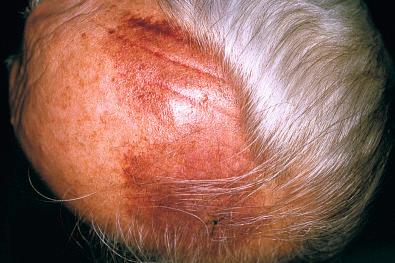
Grossly, the tumors consist of poorly defined hemorrhagic areas that flatten or ulcerate the overlying skin ( Fig. 22.2 ). Rarely, the epidermis displays verrucous hyperplasia. On a cut section, the tumors have a microcystic or spongelike quality because of blood-filled spaces. The tumors extensively involve the dermis and extend well beyond their apparent gross confines. In poorly differentiated, rapidly growing tumors, deep structures, such as the subcutis and fascia, are invaded. The periphery of the tumors contains a fringe of dilated lymphatic vessels surrounded by chronic inflammatory cells and usually small capillaries in which piling up and tufting of the endothelium suggest incipient malignant change.
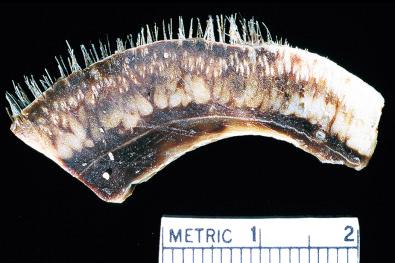
Traditionally the diagnosis of angiosarcoma is based on identification of vascular channels of irregular size and shape within a malignant tumor ( Figs. 22.3 to 22.6 ). This, however, can give rise to a wide range of appearances. At one extreme, angiosarcomas can appear so well differentiated that they can be mistaken for a hemangioma. In these cases, evaluation of the architectural pattern is critical. In contrast to hemangiomas, the vascular channels in angiosarcomas are imperfectly formed and anastomose with one another, creating a network of sinuses ( Fig. 22.4B-D ). They carve their way through tissue, dissecting through the dermal collagen ( Figs. 22.3C and 22.4A and B ) and fascia, splitting apart groups of subcutaneous fat cells ( Figs. 22.3D and 22.4C ), and isolating adnexal structures ( Fig. 22.4D ). In some cases, prominence of nucleoli can be identified within flattened endothelium of the vessels ( Fig. 22.5 ).
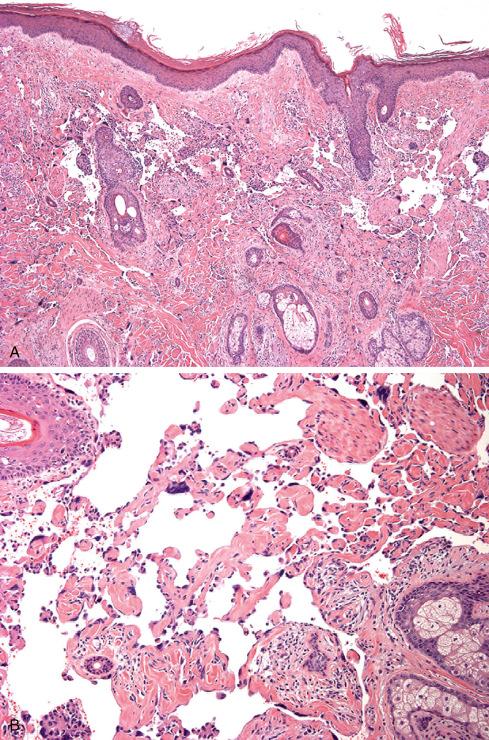
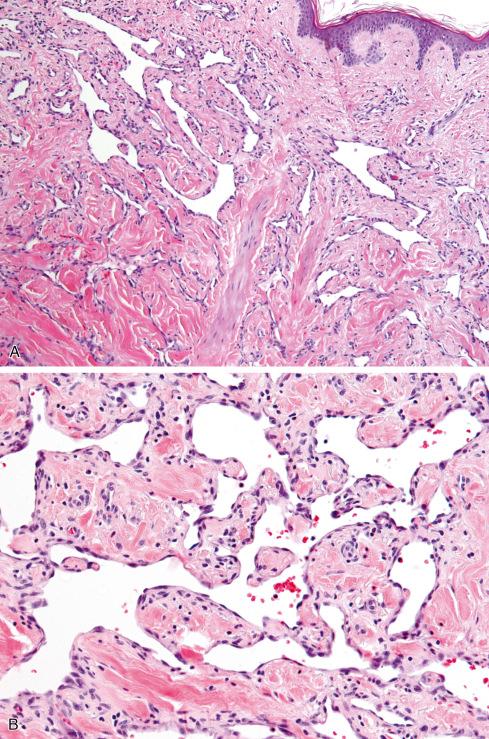
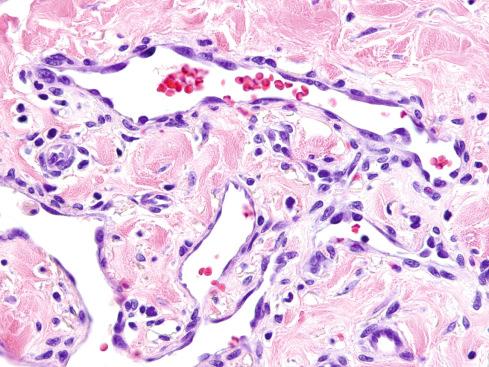
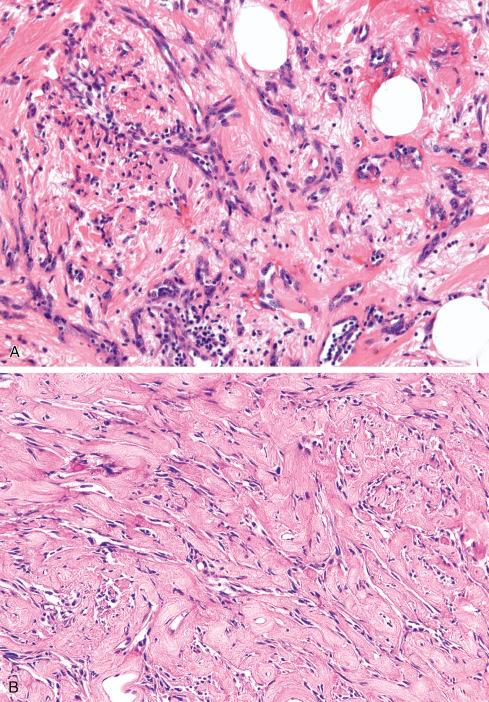
At the other extreme, poorly differentiated angiosarcomas are composed of cells of higher nuclear grade with prominent nucleoli, which can vary from spindled to rounded, such that the differential diagnosis embraces a range of tumors from sarcoma to carcinoma ( Fig. 22.6 ). Rudimentary vessels are lined by redundant endothelium often thrown into papillations. In addition to vasoformative areas, poorly differentiated angiosarcomas frequently have expanses of solid-appearing areas.
A rare form of angiosarcoma is the foamy cell variant . Composed of sheets of cytologically bland, finely vacuolated endothelial cells, these lesions are easily mistaken for a xanthomatous reaction ( Fig. 22.7 ). Those with more atypia may bring to mind a signet-ring carcinoma.
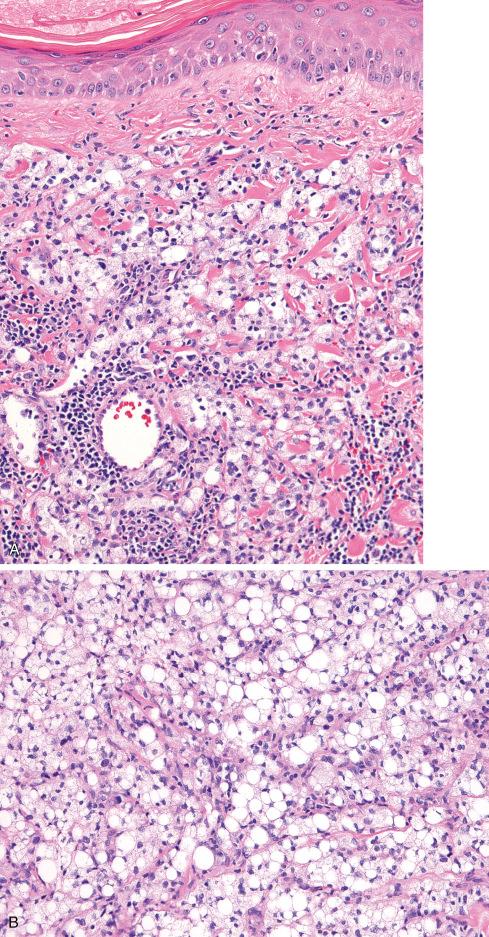
IHC confirmation of the diagnosis of angiosarcoma can usually be accomplished using a panel of vascular markers (see Chapter 6 ). Using both CD34 and CD31, almost all angiosarcomas, even poorly differentiated ones, can be identified, although with a few caveats. CD34 is expressed by many angiosarcomas and Kaposi sarcoma, but it is also seen in some soft tissue tumors (e.g., epithelioid sarcoma) that may enter into the differential diagnosis of angiosarcoma. CD31 (platelet-endothelial cell adhesion molecule), on the other hand, seems to be the more sensitive and more specific antigen for endothelial differentiation ( Fig. 22.8A ). In the context of soft tissue neoplasia, virtually all benign and malignant vascular tumors express this membrane protein, whereas nonvascular tumors do not. Because histiocytes are CD31 positive in a granular membranous pattern, it is important to assess accurately the characteristics of positive cells. The prudent approach is to use IHC studies to rule out other diagnoses that may legitimately enter the differential diagnosis, coupled with a panel of vascular markers (e.g., CD31, CD34) that, if positive, support the diagnosis of angiosarcoma.
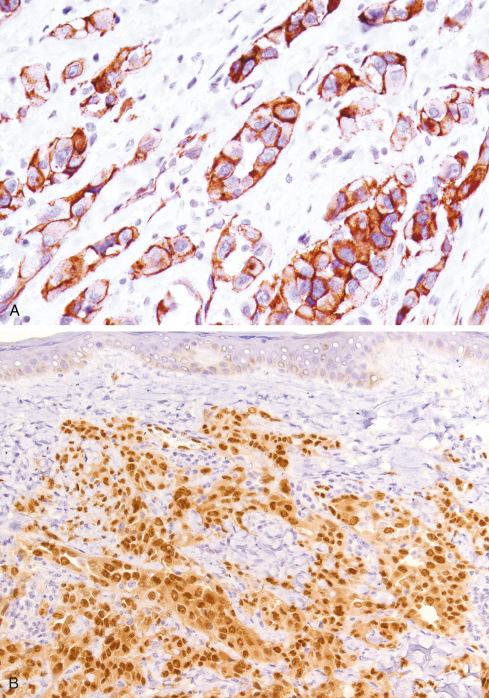
Newer antibodies to FLI1 and ERG proteins are highly sensitive and relatively highly specific markers of angiosarcoma. FLI1, a nuclear transcription factor, has been shown to identify more than 95% of vascular tumors, regardless of type and level of malignancy. However, it is also expressed by some adenocarcinomas and melanomas, making it important that one not prejudge a malignant tumor as an angiosarcoma without considering these as well. ERG, an ETS family transcription factor, is expressed in normal endothelial cells. Nuclear ERG expression has recently been shown to be an exquisitely sensitive marker of vascular differentiation ( Fig. 22.8B ). In a study of more than 200 vascular tumors, Miettinen et al. have shown that virtually all benign and malignant vascular tumors express the protein, including lymphatic lesions as well. Because ERG expression is highly retained in angiosarcomas, it indicates that the marker is independent of the level of malignancy. As with FLI1, ERG expression can be seen in nonendothelial tumors, including Ewing sarcoma, prostatic adenocarcinoma, myeloid malignancies, and epithelioid sarcoma. In general, we find that FLI1 and ERG are best used as secondary markers for the confirmation of endothelial differentiation in tumors where CD31 is less than fully diagnostic. Smooth muscle actin immunostains can be used to judge the presence of pericytes investing the endothelium in histologically ambiguous vascular lesions, since angiosarcomas typically lack pericytes. However, care must be exercised not to misinterpret stromal myofibroblasts as pericytes. Very rare angiosarcomas show aberrant expression of neuroendocrine markers, most often synaptophysin and CD56.
As noted earlier, MYC amplification and MYC protein overexpression are not generally features of primary cutaneous angiosarcomas. Shon et al. noted MYC overexpression in only 9 of 38 primary cutaneous angiosarcomas (24%), only two of which showed high-level MYC amplification by fluorescence in situ hybridization (FISH). Ginter et al. and Requena et al. reported similar findings. Thus, unlike in postirradiation angiosarcoma (see later), where the finding of MYC amplification and MYC overexpression may be very helpful in distinguishing angiosarcoma from benign mimics, these tests are not helpful in the evaluation of primary cutaneous angiosarcoma.
The overall 5-year survival of patients with cutaneous angiosarcomas varies from 30% to 50%. Most patient deaths are the result of metastases to lung, liver, and lymph node. Outcome is influenced by factors such as age, size, and margin status. Younger patients have a decidedly better prognosis than older patients. In a retrospective analysis of patients entered into the Surveillance, Epidemiology and End Results (SEER) Program, patients younger than 50 years had a 10-year relative survival rate of 71.7%, compared to 36.8% for those older than 50 years. A similar trend has been reported by others.
Size is also consistently linked to outcome. In the past, most angiosarcomas were large (>5 cm) at presentation, but this has changed. Approximately one-half of angiosarcomas now are less than 5 cm at presentation. Tumors less than 5 cm in diameter (T1) have a significantly better prognosis than larger tumors (T2). Mark et al. reported a 5-year survival of 32% for lesions less than 5 cm compared to 13% for those greater than 5 cm, and Pawlik et al. noted a mortality of less than 10% in patients with lesions less than 5 cm and 75% in those with lesions greater than 5 cm. It should be noted that pathologic size correlates better with outcome than clinical size because the latter often underestimates the size.
Negative margin status is highly correlated with improved survival, although it is both difficult to achieve negative margins in angiosarcoma and to assess them at frozen section. At one institution, as many as two-thirds of margins interpreted as negative at frozen section were judged to be positive on permanent section. For this reason, Pawlik et al. recommend that reconstruction surgery be postponed until the results of permanent sections are available.
Although conventional histologic grading is not widely applied to angiosarcomas, Deyrup et al. proposed a risk stratification scheme based on a combination of necrosis and epithelioid morphology. Patients whose tumors had both (high-risk histologic group) had a 24% 3-year survival. In contrast, patients whose tumors lacked both (low-risk histologic group) had a 77% 3-year survival. The importance of necrosis and epithelioid appearance in prognosis has been validated by others. A purely epithelioid form of cutaneous angiosarcoma with a predilection for the extremities and an aggressive course has been described.
In 1949, Stewart and Treves reported six patients who developed vascular sarcomas (so-called lymphangiosarcoma) following radical mastectomy and axillary lymph node dissection for breast carcinoma. Although some of the patients had also undergone radiotherapy, the common denominator in each appeared to be the presence of chronic lymphedema , which usually supervened shortly after mastectomy. Since this original description, many cases of vascular sarcomas complicating chronic lymphedema have been recorded. Not unexpectedly, most have occurred in women after mastectomy, although tumors have been documented on the abdominal wall after lymph node dissection for carcinoma of the penis and the arm or leg affected by congenital, idiopathic, traumatic, and filarial lymphedema. Recently, angiosarcomas have also been reported in obesity-associated lymphedema (localized massive lymphedema). This has led to the conjecture that the obesity epidemic may well increase the incidence of angiosarcoma.
Become a Clinical Tree membership for Full access and enjoy Unlimited articles
If you are a member. Log in here